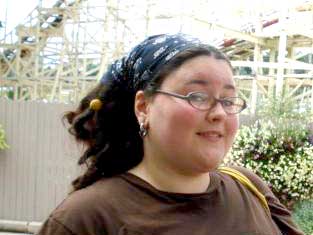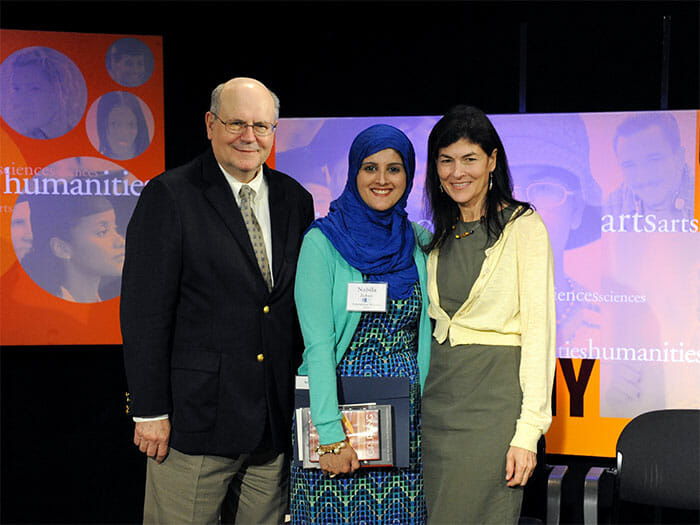Sierra Kessler, a senior and American Studies major at the College of Staten Island, is putting her love of history to good use as she interns at the Museum of Jewish Heritage in Manhattan.
Kessler secured the internship at the museum, thanks to the help of CSI Assistant Professor of History, Catherine Lavender, who initially told her about the opportunity, and then went the extra mile when she and Kessler realized that they had missed the deadline for application.
As Kessler recalls, “Catherine called up and explained that we just heard about it, and was there any hope, and they gave me an extension (it was a Thursday; I had to deliver my application to the museum Monday morning). I got everything together and luckily got the interview, and consequently the internship!”
This isn’t Kessler’s first foray into this type of work, as she says that she has worked for the Education Department at Historic Richmond Town for the past ten years. “I started as an apprentice, in a sort of summer camp setting, interned/volunteered, and am now a paid employee. It’s a living history museum where I dress up (time depending on what I am doing, from 1700s to mid/late 1800s) and interpret different aspects of American (but focused on Staten Island/NY) life of the time period. I am an expert in fireplace cooking and basket making. Giving tours and showing students, or adult visitors, what life was like at Historic Richmond Town is what made me recognize a love of history as well as a love of teaching.”
Kessler’s experience at the Museum of Jewish Heritage has involved a two-step process—an intensive training period and its culmination, the hosting and teaching of student groups when they visit the museum. “The first part is a Pre-Visit in the classroom,” Kessler notes. “Here my partner and I go over a series of slides that will help the students know what to expect at the museum and also help us gauge how much they know about the Holocaust and Jewish heritage/culture. The second portion is a guided tour of the museum, entitled “Meeting Hate with Humanity.” It covers the museum’s three floors, each with its own theme (very basically, the first floor is Jewish Heritage/Culture before the war, the second floor is World War 2, and third floor is renewal and recovery after the war). Finally there is a Post-Visit at the classroom again, where we discuss any questions the students had about the museum that we couldn’t get to. Here is where we also talk about ways of looking toward the future and the idea of personal responsibility for helping the human condition worldwide.”
How does Kessler feel about the internship, so far? “I think that the internship is great because not only did it help me as a museum interpreter, since this museum focuses on an entirely different aspect of history than I was used to, but the goal of what we are teaching students. The focus of the museum is more than just looking at the Holocaust and saying ‘Oh well that was a horrible thing’ which, unfortunately, is what I believe happens in most junior high/high school settings. The museum helps break down that powerful number of six million [Jewish victims] and takes a closer look at individual victims, survivors, and rescuers. Not only does it help humanize the event and help students make closer connections, but it serves as an awakening to current world events.”
Beyond that, Kessler discusses another important facet of the lessons learned at the museum. “There are a lot of students who hear about [the genocide in] Darfur [Sudan] and think it is half the globe away and thus irrelevant to their lives. But when they acknowledge that a lot of people thought that way during the Holocaust and now we can look back with shame and horror at the lack of a faster world response, the small amount of resistance and rescuers, [this] helps students realize that if something is happening in the world, no matter what or where, they have a voice and can do something. I like this internship because it allows me not only to teach about history, which is amazingly important, but also that I am able to encourage youth to be conscious and active in the world around them.”
Looking to the future after CSI, Kessler says, “my plans at this point are to hopefully get into graduate school for Museum Studies. I love teaching in a museum setting, as it allows me to focus on what I like and not a very broad curriculum, and I also have the luxury in a museum of more often than not having visitors who are genuinely interested and not forced to show up. I am not certain what kind of museum I want to work in just at this moment, as I’ve started looking into different areas of history and find them all fascinating. As for the near future, I am going to an interview next week for another internship that the Museum of Jewish Heritage is a part of, which is in Poland, studying Jewish life before and after the war. My goal is to understand the experience of European Jewry in order to get a better idea of the environment from which many American Jews came.”





![[videos, galleries] Graduates Honored at 37th Commencement](https://csitoday.com/wp-content/uploads/2013/06/Commencement-2013-060313.jpg)











